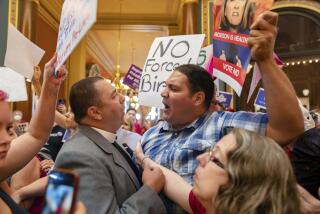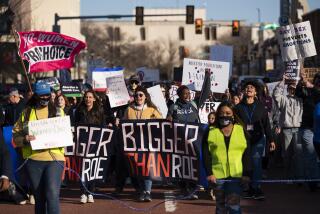Court to Review States’ Right to Curb Abortions
- Share via
WASHINGTON — With a new but largely untested conservative majority in charge, the Supreme Court announced Monday that it again will consider to what extent states may restrict a woman’s access to abortion.
The justices agreed to review a federal appellate ruling last year that struck down as unconstitutional a 1986 Missouri law that banned any use of public facilities or employees for “performing or assisting” abortions.
The case (Webster vs. Reproductive Health Services, 88-605), to be decided by July, is likely to be the focus of extraordinary attention because the high court is believed ready to change directions on abortion.
No Curbs on Private Clinics
In and of itself, the case may not yield a landmark ruling. The state law at issue puts no restrictions on abortions in private clinics, where more than 90% of Missouri’s abortions take place.
However, women’s rights advocates fear, and right-to-life advocates hope, that a high court ruling upholding the law would virtually invite other states to enact even more restrictive abortion laws.
“This could be the first step back toward sanity,” said Douglas Johnson, legislative director of the National Right to Life Committee.
Justice Harry A. Blackmun, author of the 1973 Roe vs. Wade ruling, which established a woman’s right to terminate a pregnancy in its first months, fueled speculation last summer that a new abortion standard could be upcoming when he told a law school audience that “there is a distinct possibility” the Roe ruling could be overturned.
In reviewing the issue, the justices will consider several key parts of the Missouri law, including:
--A preamble declaring that “the life of each human being begins at conception.” The state says that this language has no practical impact, but the U.S. 8th Circuit Court of Appeals, in throwing out the law, said that it reflects “an impermissible theory of life” that flatly contradicts the Roe decision.
--A ban on the use of any public funds for “encouraging or counseling a woman to have an abortion.” The lower court said that the phrase is vague and could prevent doctors from giving women crucial medical advice.
--A ban on public employees acting to “perform or assist” an abortion.
--A ban on the use of public facilities to perform or assist abortions.
Missouri state officials assert that their law merely attempts to remove all public subsidies for abortion.
“The fact is, people in this state don’t want their tax money spent on abortion,” said Michael Boicourt, an assistant to Missouri Atty. Gen. William Webster. “This is mostly a statement of principle. It will not have much practical effect.”
However, Kate Michelman, executive director of the National Abortion Rights Action League, said that the court’s decision to hear Missouri’s appeal is “truly alarming” and poses the “most serious threat to reproductive choice in America in decades.”
At the very least, she said, the law would make it more difficult for women, especially poor ones, to get abortions. Taking a less pessimistic stance, David J. Andrews, acting president of Planned Parenthood Federation, said he is “confident that the court will not acquiesce to the Reagan Administration’s far-fetched request to reverse Roe vs. Wade . . . to appeal to an extremist minority.”
The Justice Department has announced that it supports Missouri’s appeal. “If the court is prepared to reconsider Roe vs. Wade, this case presents an appropriate opportunity for doing so,” outgoing Solicitor General Charles Fried said in a brief urging that the state law be upheld.
Right-to-life advocate Johnson said he would be surprised if the high court chose to completely overturn the landmark abortion ruling, but he is encouraged that it may now be willing to consider some restrictions.
“To this point, they have struck down even the most trivial restrictions on abortion,” he said.
Sixteen years ago this month, the Supreme Court, on a 7-2 vote, struck down all state laws making abortion a crime and declared that the Constitution gives women a right to end early pregnancies--defined as those in the first trimester--free of government intrusion. Since then, the justices have invalidated an array of state and municipal regulations that were seen as infringing on the abortion right.
Virtually the only regulations approved by the court were those requiring that abortions be performed by licensed doctors and that the government need not pay for abortions. (Some state supreme courts, including California’s, read their state constitutions as requiring that public funding be made available for abortions under some circumstances.)
The Supreme Court last affirmed its Roe ruling in 1986, but in a narrow 5-4 opinion. Since then, one conservative justice and one liberal have retired. They were replaced by two conservative Reagan appointees: Justices Antonin Scalia and Anthony M. Kennedy.
In addition, the governor who approved the state abortion restrictions that led to the 1986 ruling is now the U.S. attorney general. As the top legal officer in the new Bush Administration, former Pennsylvania Gov. Dick Thornburgh says he will continue to press the high court to overturn the Roe decision.
Legal analysts say they believe that the fate of the abortion rulings probably depends on Justices Sandra Day O’Connor and Kennedy. The four who have taken a liberal view of the issue--Justices William J. Brennan Jr., Thurgood Marshall, John Paul Stevens and Blackmun--have maintained that abortion is a woman’s right. Those on the conservative side, led by Chief Justice William H. Rehnquist and Justice Byron R. White, disagree and say that state legislatures should decide the issue. Most legal experts believe that Scalia shares this view.
Kennedy, who joined the court last February, has not publicly expressed an opinion.
By contrast, O’Connor has put forth a detailed--if still somewhat hazy--middle position. In lengthy dissents in 1983 and 1986, she said that she would give states more leeway to enact medical or spending regulations covering abortion, so long as the rules did not create “an undue burden” or “severe limitations” on a woman’s decision to end her pregnancy.
In other actions Monday, the high court:
--In a victory for environmentalists, let stand an appeals court ruling preventing the government from allowing Japanese fisherman to use huge fishing nets off the Alaska coast. A lower court invoked a 1972 law protecting endangered marine mammals to stop the use of nets that could snare porpoises, fur seals and sea lions (Verity vs. Center for Environmental Education, 88-428).
--Refused to stop a trial in Alabama in which the lawyer for two Ku Klux Klansmen accused of murder says he will seek to exclude blacks from the jury. In 1986, the high court said prosecutors may not take race into account when selecting jurors, and the court was urged to apply the same ruling to defense lawyers. But only two justices said that they wanted to hear the case (Alabama vs. Cox, 88-630). However, if the klansmen were freed by an all-white jury, the high court could hear the state’s appeal later.
More to Read
Get the L.A. Times Politics newsletter
Deeply reported insights into legislation, politics and policy from Sacramento, Washington and beyond. In your inbox twice per week.
You may occasionally receive promotional content from the Los Angeles Times.











